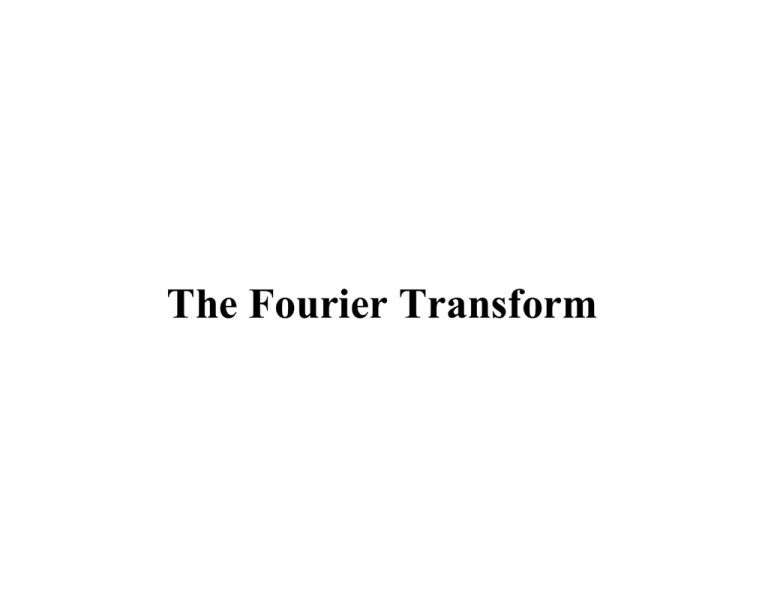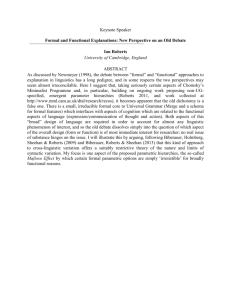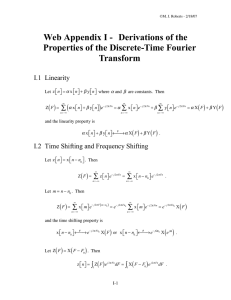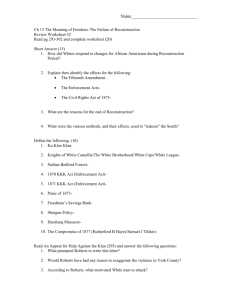The Fourier Transform
advertisement

The Fourier Transform Extending the CTFS • The CTFS is a good analysis tool for systems with periodic excitation but the CTFS cannot represent an aperiodic signal for all time • The continuous-time Fourier transform (CTFT) can represent an aperiodic signal for all time 5/10/04 M. J. Roberts - All Rights Reserved 2 CTFS-to-CTFT Transition w Consider a periodic pulse-train signal, x(t), with duty cycle, T0 Its CTFS harmonic function is X[ k ] = kw Aw sinc T0 T0 As the period, T0 , is increased, holding w constant, the duty cycle is decreased. When the period becomes infinite (and the duty cycle becomes zero) x(t) is no longer periodic. 5/10/04 M. J. Roberts - All Rights Reserved 3 CTFS-to-CTFT Transition Below are plots of the magnitude of X[k] for 50% and 10% duty cycles. As the period increases the sinc function widens and its magnitude falls. As the period approaches infinity, the CTFS harmonic function becomes an infinitely-wide sinc function with zero amplitude. T0 w= 2 5/10/04 M. J. Roberts - All Rights Reserved T0 w= 10 4 CTFS-to-CTFT Transition This infinity-and-zero problem can be solved by normalizing the CTFS harmonic function. Define a new “modified” CTFS harmonic function, T0 X[ k ] = Aw sinc( w( kf0 )) and graph it versus kf0 instead of versus k. 5/10/04 M. J. Roberts - All Rights Reserved 5 CTFS-to-CTFT Transition In the limit as the period approaches infinity, the modified CTFS harmonic function approaches a function of continuous frequency f ( kf0 ). 5/10/04 M. J. Roberts - All Rights Reserved 6 Definition of the CTFT Forward X( f ) = F ( x(t )) = ∞ ∫ Inverse f form x(t ) = F -1( X( f )) = x(t )e − j 2πft dt −∞ X( jω ) = F ( x(t )) = ∫ ∫ X( f )e + j 2πft df −∞ Forward ∞ ∞ ω form x(t )e − jωt dt −∞ Inverse ∞ 1 -1 + jωt x(t ) = F ( X( jω )) = X j ω e dω ( ) ∫ 2π −∞ Commonly-used notation: F x(t ) ← → X( f ) 5/10/04 or F x(t ) ← → X( jω ) M. J. Roberts - All Rights Reserved 7 Some Remarkable Implications of the Fourier Transform The CTFT expresses a finite-amplitude, real-valued, aperiodic signal which can also, in general, be time-limited, as a summation (an integral) of an infinite continuum of weighted, infinitesimalamplitude, complex sinusoids, each of which is unlimited in time. (Time limited means “having non-zero values only for a finite time.”) 5/10/04 M. J. Roberts - All Rights Reserved 8 Frequency Content Highpass Lowpass Bandpass 5/10/04 M. J. Roberts - All Rights Reserved 9 Convergence and the Generalized Fourier Transform Let x(t ) = A . Then from the definition of the CTFT, X( f ) = ∞ ∫ −∞ ∞ Ae − j 2πft dt = A ∫ e − j 2πft dt −∞ This integral does not converge so, strictly speaking, the CTFT does not exist. 5/10/04 M. J. Roberts - All Rights Reserved 10 Convergence and the Generalized Fourier Transform But consider a similar function, xσ (t ) = Ae − σ t , σ > 0 Its CTFT integral, Xσ ( f ) = ∞ ∫ Ae − σ t e − j 2πft dt −∞ does converge. 5/10/04 M. J. Roberts - All Rights Reserved 11 Convergence and the Generalized Fourier Transform 2σ Carrying out the integral, Xσ ( f ) = A 2 2 . σ + ( 2πf ) Now let σ approach zero. 2σ If f ≠ 0 then lim A 2 2 = 0 . The area under this σ →0 σ + ( 2πf ) function is ∞ 2σ Area = A ∫ 2 2 df −∞ σ + ( 2πf ) which is A, independent of the value of σ. So, in the limit as σ approaches zero, the CTFT has an area of A and is zero unless f = 0 . This exactly defines an impulse of strength, A. Therefore 5/10/04 F A ← → Aδ ( f ) M. J. Roberts - All Rights Reserved 12 Convergence and the Generalized Fourier Transform By a similar process it can be shown that 1 cos( 2πf0t ) ←→ [δ ( f − f0 ) + δ ( f + f0 )] 2 F and j sin( 2πf0t ) ←→ [δ ( f + f0 ) − δ ( f − f0 )] 2 F These CTFT’s which involve impulses are called generalized Fourier transforms (probably because the impulse is a generalized function). 5/10/04 M. J. Roberts - All Rights Reserved 13 Convergence and the Generalized Fourier Transform 5/10/04 M. J. Roberts - All Rights Reserved 14 Negative Frequency This signal is obviously a sinusoid. How is it described mathematically? It could be described by 2πt x(t ) = A cos = A cos( 2πf0t ) T0 But it could also be described by x(t ) = A cos( 2π ( − f0 )t ) 5/10/04 M. J. Roberts - All Rights Reserved 15 Negative Frequency x(t) could also be described by e j 2πf 0 t + e − j 2πf 0 t x(t ) = A 2 or x(t ) = A1 cos( 2πf0t ) + A2 cos( 2π ( − f0 )t ) , A1 + A2 = A and probably in a few other different-looking ways. So who is to say whether the frequency is positive or negative? For the purposes of signal analysis, it does not matter. 5/10/04 M. J. Roberts - All Rights Reserved 16 CTFT Properties If F ( x(t )) = X( f ) or X( jω ) and F ( y(t )) = Y( f ) or Y( jω ) then the following properties can be proven. Linearity 5/10/04 F α x(t ) + β y(t ) ← → α X( f ) + β Y( f ) F α x(t ) + β y(t ) ← → α X( jω ) + β Y( jω ) M. J. Roberts - All Rights Reserved 17 CTFT Properties Time Shifting F x(t − t 0 ) ← → X( f )e − j 2πft0 F x(t − t 0 ) ← → X( jω )e − jωt 0 5/10/04 M. J. Roberts - All Rights Reserved 18 CTFT Properties Frequency Shifting F x(t )e + j 2πf 0 t ← → X( f − f0 ) F x(t )e + jω 0 t ← → X(ω − ω 0 ) 5/10/04 M. J. Roberts - All Rights Reserved 19 CTFT Properties 1 f x( at ) ←→ X a a 1 ω F x( at ) ←→ X j a a F Time Scaling 1 t F x ←→ X( af ) a a Frequency Scaling 5/10/04 1 t F x ←→ X( jaω ) a a M. J. Roberts - All Rights Reserved 20 The “Uncertainty” Principle The time and frequency scaling properties indicate that if a signal is expanded in one domain it is compressed in the other domain. This is called the “uncertainty principle” of Fourier analysis. − π2t 2 −πt e 5/10/04 − πf 2 2 −π f ← →2ee ← → ee t −π 2 F F 2 F ←→ 2 e −π ( 2 f )2 M. J. Roberts - All Rights Reserved 21 CTFT Properties F x* (t ) ← → X* ( − f ) Transform of a Conjugate F x* (t ) ← → X* ( − jω ) F x(t ) ∗ y(t ) ← → X( f ) Y( f ) MultiplicationConvolution Duality F x(t ) ∗ y(t ) ← → X( jω ) Y( jω ) F x(t ) y(t ) ← → X( f ) ∗ Y( f ) 1 x(t ) y(t ) ←→ X( jω ) ∗ Y( jω ) 2π F 5/10/04 M. J. Roberts - All Rights Reserved 22 CTFT Properties 5/10/04 M. J. Roberts - All Rights Reserved 23 CTFT Properties An important consequence of multiplication-convolution duality is the concept of the transfer function. In the frequency domain, the cascade connection multiplies the transfer functions instead of convolving the impulse responses. 5/10/04 M. J. Roberts - All Rights Reserved 24 CTFT Properties Time Differentiation d (x(t )) ←F → j 2πf X( f ) dt d (x(t )) ←F → jω X( jω ) dt F x(t ) cos( 2πf0t ) ← → Modulation Transforms of Periodic Signals F x(t ) cos(ω 0t ) ← → x(t ) = x(t ) = ∞ ∑ X[k ]e k =−∞ ∞ ∑ X[k ]e 1 X( f − f0 ) + X( f + f0 )] [ 2 [ ] 1 X( j (ω − ω 0 )) + X( j (ω + ω 0 )) 2 − j 2π ( kf F ) t − j ( kω F ) t ←→ X( f ) = F ∑ X[k ]δ ( f − kf ) 0 k =−∞ ←→ X( jω ) = 2π F k =−∞ 5/10/04 ∞ M. J. Roberts - All Rights Reserved ∞ ∑ X[k ]δ (ω − kω ) 0 k =−∞ 25 CTFT Properties 5/10/04 M. J. Roberts - All Rights Reserved 26 CTFT Properties ∞ ∫ x(t ) ∞ 2 −∞ Parseval’s Theorem Integral Definition of an Impulse dt = ∫ X( f ) 2 df −∞ ∞ ∞ 1 2 ∫−∞ x(t ) dt = 2π −∞∫ X( jω ) df 2 ∞ ∫ e − j 2πxy dy = δ ( x ) −∞ F F X(t ) ← → x( − f ) and X( − t ) ← → x( f ) Duality 5/10/04 F F X( jt ) ← → 2π x( −ω ) and X( − jt ) ← → 2π x(ω ) M. J. Roberts - All Rights Reserved 27 CTFT Properties Total-Area Integral ∞ ∞ = ∫ x(t )dt X( 0 ) = ∫ x(t )e − j 2πft dt f →0 −∞ −∞ ∞ ∞ x( 0 ) = ∫ X( f )e + j 2πft df = ∫ X( f )df t→0 −∞ −∞ ∞ ∞ = ∫ x(t )dt X( 0 ) = ∫ x(t )e − jωt dt ω →0 −∞ −∞ ∞ 1 ∞ 1 + jωt ω x( 0 ) = X j e dω = X( jω )dω ( ) ∫ ∫ t→0 2π −∞ 2π −∞ X( f ) 1 ∫−∞ x(λ )dλ ←→ j 2πf + 2 X(0)δ ( f ) t X( jω ) F ∫ x(λ )dλ ←→ jω + π X(0)δ (ω ) −∞ t Integration 5/10/04 F M. J. Roberts - All Rights Reserved 28 CTFT Properties X( 0 ) = ∞ ∫ x(t )dt −∞ x( 0 ) = ∞ ∫ X( f )df −∞ 5/10/04 M. J. Roberts - All Rights Reserved 29 CTFT Properties 5/10/04 M. J. Roberts - All Rights Reserved 30 Extending the DTFS • Analogous to the CTFS, the DTFS is a good analysis tool for systems with periodic excitation but cannot represent an aperiodic DT signal for all time • The discrete-time Fourier transform (DTFT) can represent an aperiodic DT signal for all time 5/10/04 M. J. Roberts - All Rights Reserved 31 DTFS-to-DTFT Transition DT Pulse Train This DT periodic rectangular-wave signal is analogous to the CT periodic rectangular-wave signal used to illustrate the transition from the CTFS to the CTFT. 5/10/04 M. J. Roberts - All Rights Reserved 32 DTFS-to-DTFT Transition DTFS of DT Pulse Train As the period of the rectangular wave increases, the period of the DTFS increases and the amplitude of the DTFS decreases. 5/10/04 M. J. Roberts - All Rights Reserved 33 DTFS-to-DTFT Transition Normalized DTFS of DT Pulse Train By multiplying the DTFS by its period and plotting versus kF0 instead of k, the amplitude of the DTFS stays the same as the period increases and the period of the normalized DTFS stays at one. 5/10/04 M. J. Roberts - All Rights Reserved 34 DTFS-to-DTFT Transition The normalized DTFS approaches this limit as the DT period approaches infinity. 5/10/04 M. J. Roberts - All Rights Reserved 35 Definition of the DTFT F Form Inverse x[n ] = ∫ X( F )e 1 Inverse j 2πFn dF ←→ X( F ) = F Forward ∞ ∑ n =−∞ Ω Form x[n ]e − j 2πFn Forward ∞ 1 F jΩn − jΩn x[n ] = X j Ω e d Ω ← → X j Ω = x n e ( ) ( ) [ ] ∑ 2π ∫2π n =−∞ 5/10/04 M. J. Roberts - All Rights Reserved 36 DTFT Properties Linearity 5/10/04 F α x[n ] + β y[n ]← → α X( F ) + β Y( F ) F α x[n ] + β y[n ]← → α X( jΩ) + β Y( jΩ) M. J. Roberts - All Rights Reserved 37 DTFT Properties Time Shifting 5/10/04 F x[ n − n0 ] ← → e − j 2πFn0 X( F ) F x[ n − n0 ] ← → e − jΩn0 X( jΩ) M. J. Roberts - All Rights Reserved 38 DTFT Properties Frequency Shifting Time Reversal 5/10/04 F e j 2πF0n x[n ]← → X( F − F0 ) F e jΩ 0n x[n ]← → X( j (Ω − Ω0 )) F x[− n ]← → X( − F ) F x[− n ]← → X( − jΩ) M. J. Roberts - All Rights Reserved 39 DTFT Properties Differencing 5/10/04 F x[n ] − x[n − 1]← →(1 − e − j 2πF ) X( F ) F x[n ] − x[n − 1]← →(1 − e − jΩ ) X( jΩ) M. J. Roberts - All Rights Reserved 40 DTFT Properties 1 X( F ) ∑ x[m ]←→ 1 − e− j 2πF + 2 X(0) comb( F ) m =−∞ n Accumulation 5/10/04 F X( jΩ) 1 Ω ∑ x[m]←→ 1 − e− jΩ + 2 X(0) comb 2π m =−∞ n F M. J. Roberts - All Rights Reserved 41 DTFT Properties F x[n ] ∗ y[n ]← → X( F ) Y( F ) MultiplicationConvolution Duality F x[n ] ∗ y[n ]← → X( jΩ) Y( jΩ) F x[n ] y[n ]← → X( F ) Y( F ) 1 x[n ] y[n ]←→ X( jΩ) 2π F Y( jΩ) As is true for other transforms, convolution in the time domain is equivalent to multiplication in the frequency domain 5/10/04 M. J. Roberts - All Rights Reserved 42 DTFT Properties 5/10/04 M. J. Roberts - All Rights Reserved 43 DTFT Properties Accumulation Definition of a Comb Function ∞ ∑ n =−∞ ∞ Parseval’s Theorem e j 2πFn = comb( F ) ∑ x[n ] = ∫ X( F ) dF ∑ x[n ] = n =−∞ ∞ n =−∞ 2 2 1 2 1 2 X j Ω dΩ ( ) ∫ 2π 2π The signal energy is proportional to the integral of the squared magnitude of the DTFT of the signal over one period. 5/10/04 M. J. Roberts - All Rights Reserved 44 The Four Fourier Methods 5/10/04 M. J. Roberts - All Rights Reserved 45 Relations Among Fourier Methods Discrete Frequency Continuous Frequency CT DT 5/10/04 M. J. Roberts - All Rights Reserved 46 CTFT - CTFS Relationship X( f ) = ∞ ∑ X[k ]δ ( f − kf ) 0 k =−∞ 5/10/04 M. J. Roberts - All Rights Reserved 47 CTFT - CTFS Relationship ( ) X p [ k ] = f p X kf p 5/10/04 M. J. Roberts - All Rights Reserved 48 CTFT - DTFT Relationship ∞ t 1 Let xδ (t ) = x(t ) comb = ∑ x( nTs )δ (t − nTs ) Ts n =−∞ Ts and let x[n ] = x( nTs ) There is an “information equivalence” between xδ (t ) and x[n ] . They are both completely described by the same set of numbers. X DTFT ( F ) = Xδ ( fs F ) X DTFT ( F ) = fs ∞ ∑X k =−∞ 5/10/04 f Xδ ( f ) = X DTFT fs CTFT ( fs ( F − k )) M. J. Roberts - All Rights Reserved 49 CTFT - DTFT Relationship 5/10/04 M. J. Roberts - All Rights Reserved 50 DTFS - DTFT Relationship X( F ) = ∞ ∑ X[k ]δ ( F − kF ) 0 k =−∞ 5/10/04 M. J. Roberts - All Rights Reserved 51 DTFS - DTFT Relationship ( ) 1 X p [k ] = X kFp Np 5/10/04 M. J. Roberts - All Rights Reserved 52




